1995 CHEVROLET CORVETTE weight
[x] Cancel search: weightPage 4 of 386
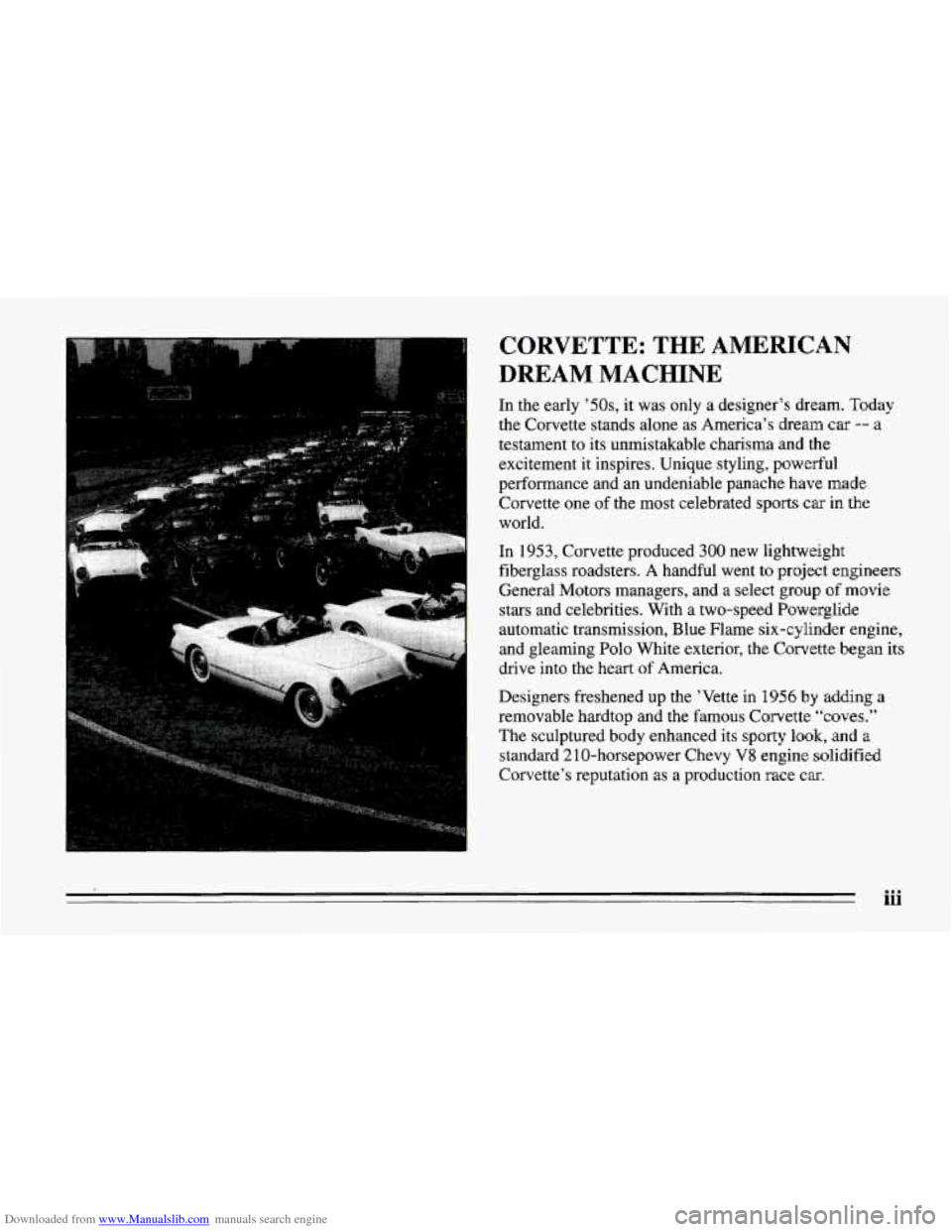
Downloaded from www.Manualslib.com manuals search engine CORVETTE: THE AMERICAN
DREAM MACHINE
In the early OS, it was only a designer’s dream. Today
the Corvette stands alone as America’s dream car
-- a
testament to its unmistakable charisma and the
excitement it inspires. Unique styling, powerful
performance and an undeniable panache
have made
Corvette one of the most celebrated sports car in the
world.
In
1953, Corvette produced 300 new lightweight
fiberglass roadsters. A handful went to project engineers
General Motors managers, and
a select group of movie
stars and celebrities. With a two-speed Powerglide
automatic transmission, Blue Flame six-cylinder engine,
and gleaming Polo White exterior,
the Corvette began its
drive into the heart of America.
Designers freshened up the ’Vette
in 1956 by adding a
removable hardtop and the famous Corvette “coves.”
The sculptured body enhanced its sporty look, and a
standard 2 1 0-horsepower Chevy V8 engine solidified
Corvette’s reputation as a production race car.
iii
Page 77 of 386
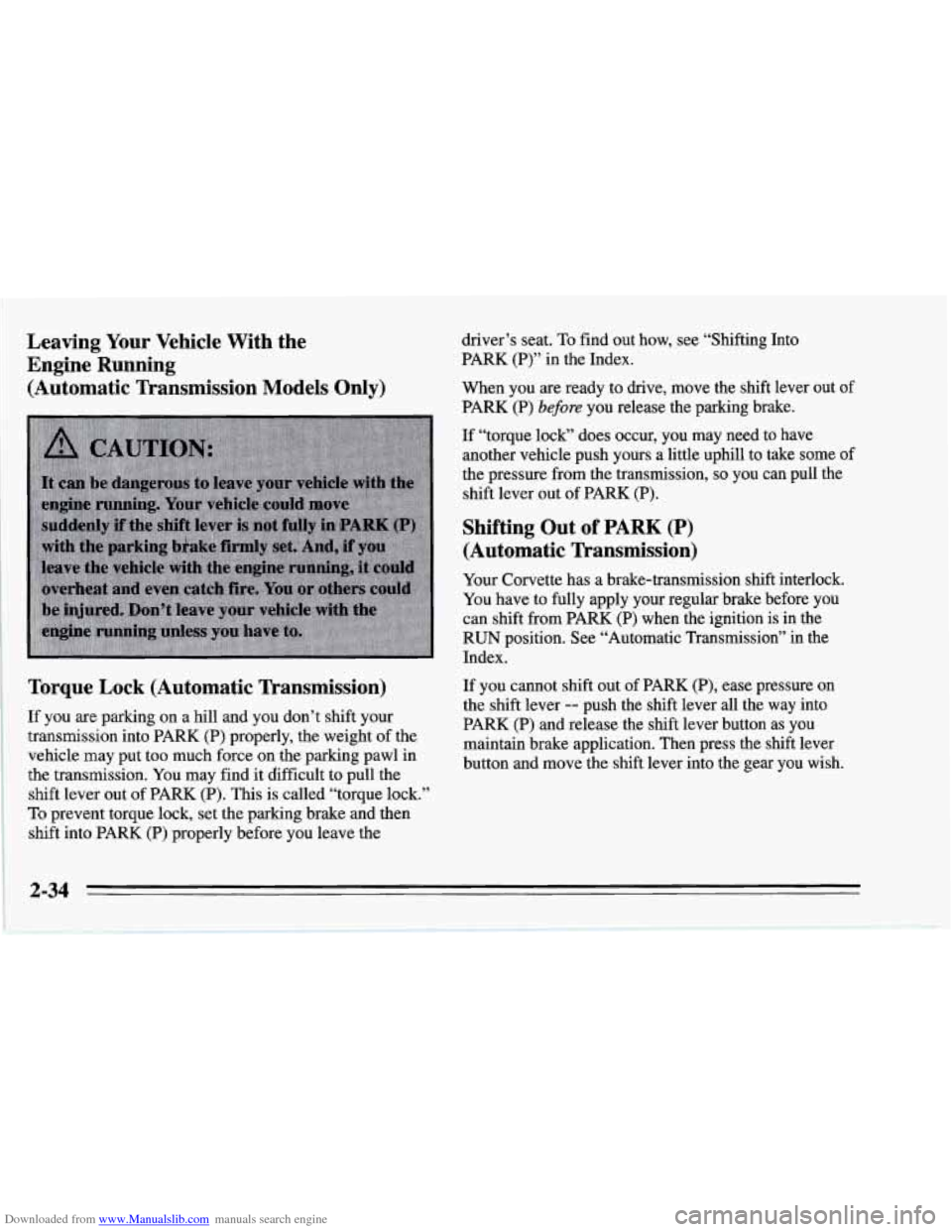
Downloaded from www.Manualslib.com manuals search engine Leaving Your Vehicle With the
Engine Running (Automatic Transmission Models Onlv)
Y‘
Torque Lock (Automatic Transmission)
If you are parking on a hill and you don’t shift your
transmission into PARK (P) properly, the weight of the
vehicle may put too much force
on the parking pawl in
the transmission. You may find it difficult to pull
the
shift lever out of PARK (P). This is called “torque lock.”
To prevent torque lock, set the parking brake and then
shift into PARK (P) properly before you leave the driver’s seat.
To find
out how, see “Shifting Into
PARK
(P)” in the Index.
When you are ready to drive, move the shift lever out of
PARK
(P) before you release the parking brake.
If “torque lock” does occur, you may need to have
another vehicle push yours a little uphill to take some
(
the pressure from the transmission, so you can pull the
shift lever out of PARK (P).
Shifting Out of PARK (P)
(Automatic Transmission)
Your Corvette has a brake-transmission shift interlock.
You have to fully apply your regular brake before you
can shift from PARK
(P) when the ignition is in the
RUN position. See “Automatic Transmission” in the
Index.
If you cannot shift out of PARK
(P), ease pressure on
the shift lever
-- push the shift lever all the way into
PARK
(P) and release the shift lever button as you
maintain brake application. Then press the shift lever
button and move the shift lever into the gear you wish.
2-34
Page 133 of 386
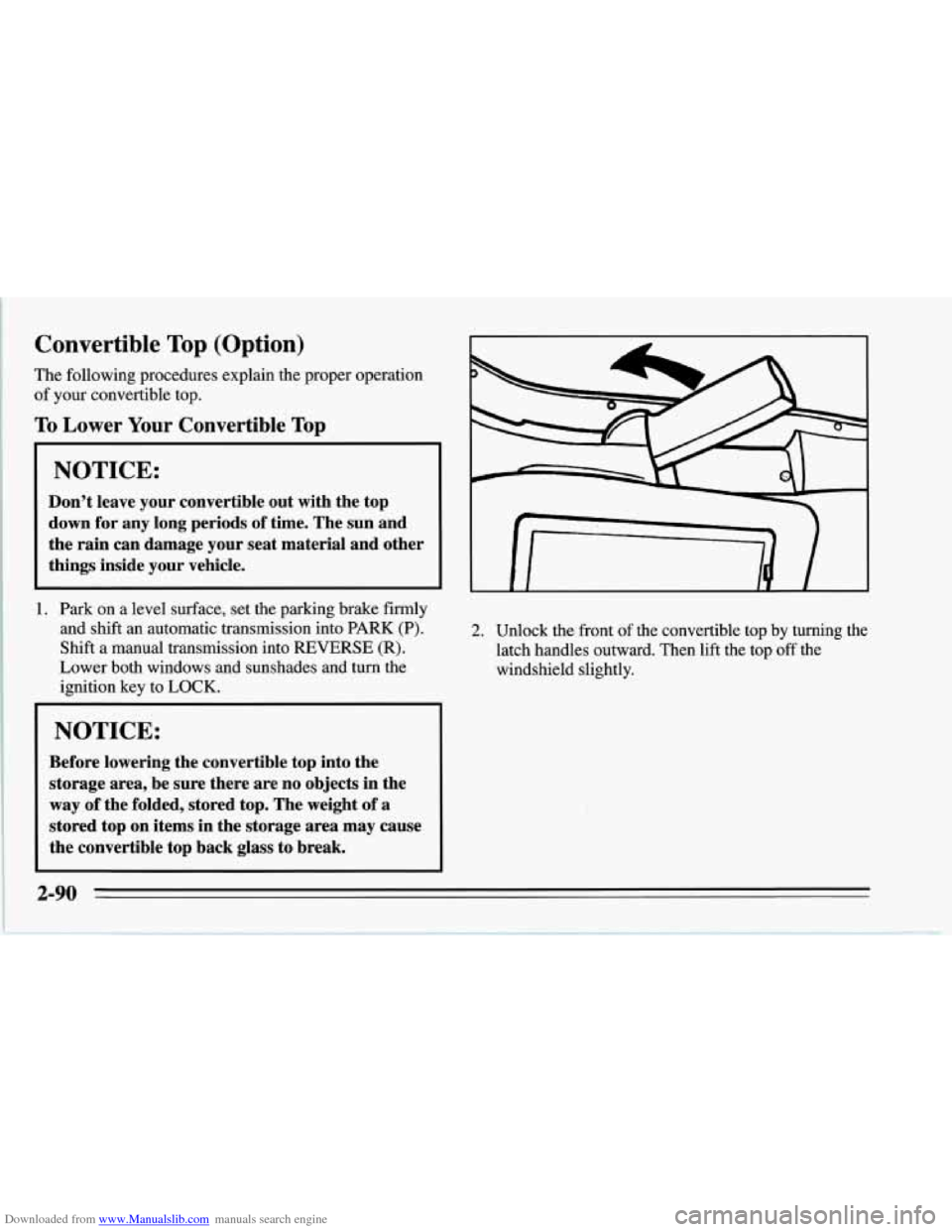
Downloaded from www.Manualslib.com manuals search engine Convertible Top (Option)
The following procedures explain the proper operation
of your convertible top.
To Lower Your Convertible Top
NOTICE:
Don’t leave your convertible out with the top
down for any long periods of time. The sun and
the rain can damage your seat material and other
things inside your vehicle.
1. Park on a level surface, set the parking brake firmly
and shift an automatic transmission into
PARK (P).
Shift a manual transmission into
REVERSE (R).
Lower both windows and sunshades and turn the
ignition key
to LOCK.
NOTICE:
Before lowering the convertible top into the
storage area, be sure there are no objects in the
way of the folded, stored top. The weight
of a
stored top on items in the storage area may cause
the convertible top back glass to break.
2. Unlock the front of the convertible top by turning the
latch handles outward. Then lift the top
off the
windshield slightly.
2-90
Page 165 of 386
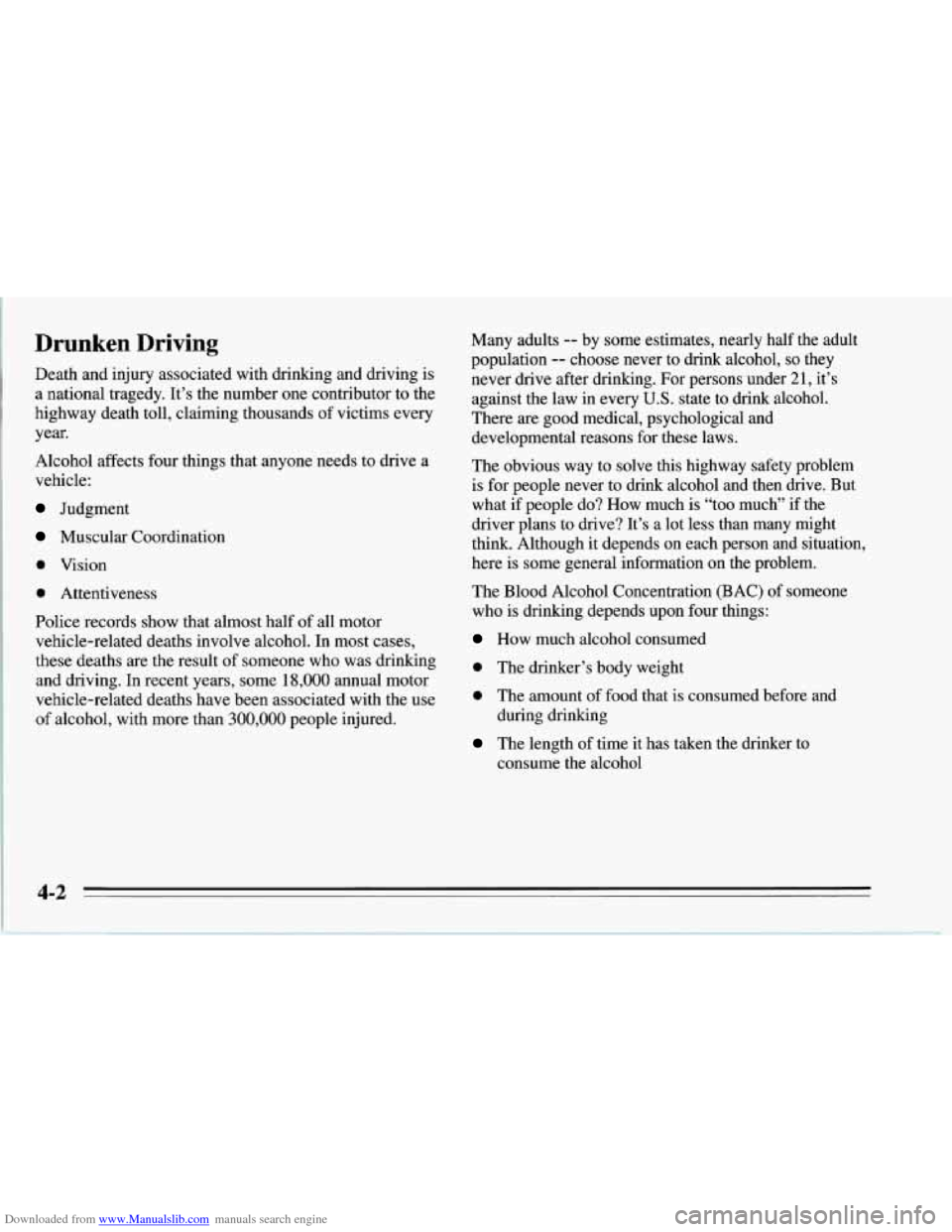
Downloaded from www.Manualslib.com manuals search engine Drunken Driving
Death and injury associated with drinking and driving is
a national tragedy. It’s the number one contributor to the
highway death toll, claiming thousands
of victims every
year.
Alcohol affects four things that anyone needs to drive a
vehicle:
Judgment
Muscular Coordination
0 Vision
~ 0 Attentiveness
~ Police records show that almost half of all motor
vehicle-related deaths involve alcohol.
In most cases,
these deaths are the result of someone who was drinking
and driving. In recent years, some
18,000 annual motor
vehicle-related deaths have been associated with the use
of alcohol, with more than 300,000 people injured. Many
adults
-- by some estimates, nearly half the adult
population
-- choose never to drink alcohol, so they
never drive after drinking. For persons under
21, it’s
against the law in every
U.S. state to drink alcohol.
There are good medical, psychological and
developmental reasons for these laws.
The obvious way to solve this highway safety problem
is for people never to drink alcohol and then drive. But
what
if people do? How much is “too much” if the
driver plans to drive? It’s a lot less than many might
think. Although it depends on each person and situation,
here is some general information on the problem.
The Blood Alcohol Concentration (BAC)
of someone
who is drinking depends upon
four things:
How much alcohol consumed
0 The drinker’s body weight
0 The amount of food that is consumed before and
during drinking
The length of time it has taken the drinker to
consume the alcohol
4-2
Page 166 of 386
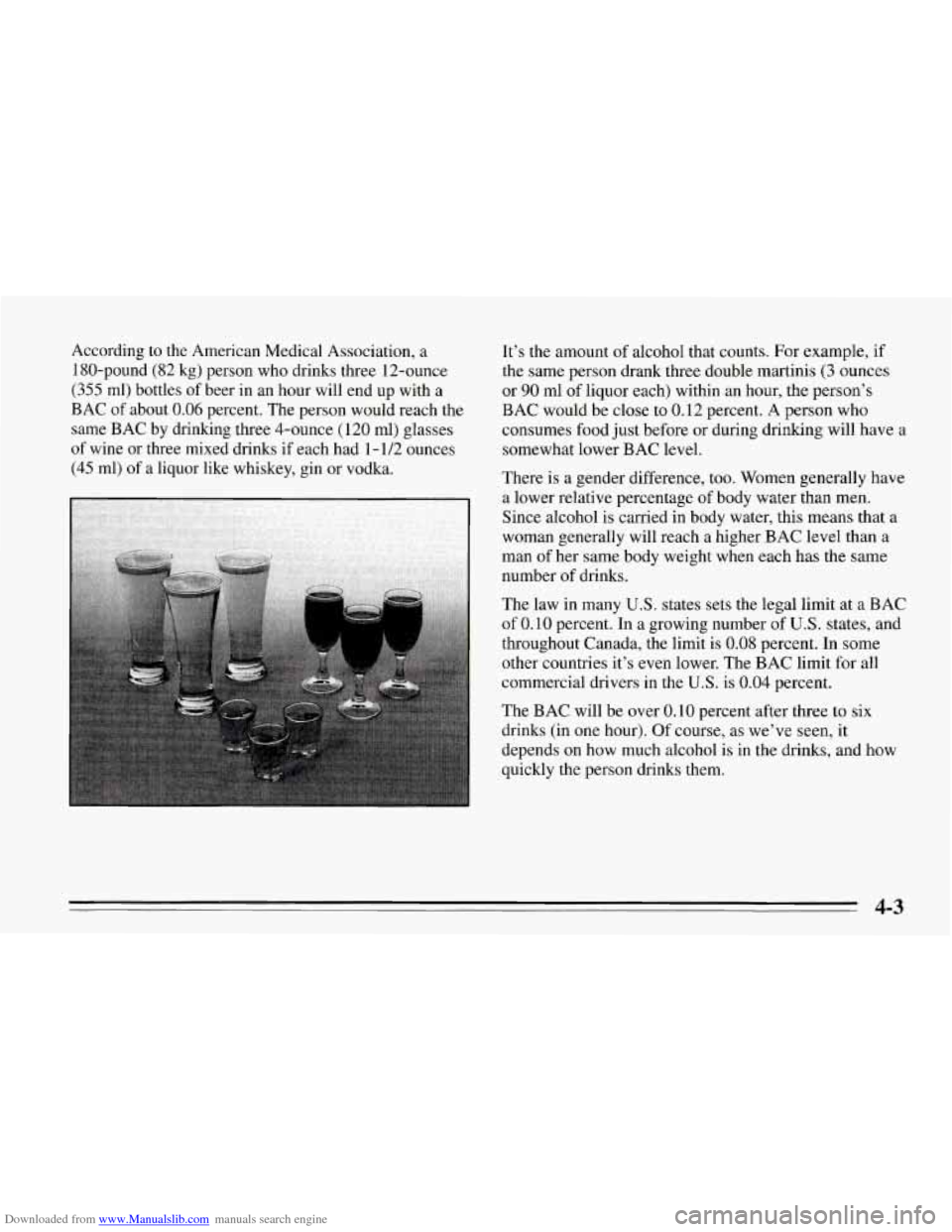
Downloaded from www.Manualslib.com manuals search engine According to the American Medical Association, a
1 80-pound (82 kg) person who drinks three 12-ounce
(355 ml) bottles of beer in an hour will end up with a
BAC of about
0.06 percent. The person would reach the
same BAC by drinking three 4-ounce (120
ml) glasses
of wine or three mixed drinks if each had 1-1/2 ounces
(45 ml) of a liquor like whiskey, gin or vodka. It’s the amount
of alcohol that counts. For example, if
the same person drank three double martinis
(3 ounces
or
90 ml of liquor each) within an hour, the person’s
BAC would be close to 0.12 percent. A person who
consumes food just before or during drinking will have a
somewhat lower BAC level.
There
is a gender difference, too. Women generally have
a lower relative percentage of body water than men.
Since alcohol is carried in body water, this means that a
woman generally will reach a higher BAC level than a
man of her same body weight when each has the same
number
of drinks.
The law in many
U.S. states sets the legal limit at a BAC
of 0.10 percent. In a growing number of U.S. states, and
throughout Canada, the limit is 0.08 percent. In some
other countries it’s even lower. The BAC limit for all
commercial drivers in the
U.S. is 0.04 percent.
The BAC will be over
0.10 percent after three to six
drinks (in one hour). Of course, as we’ve seen, it
depends on how much alcohol is
in the drinks, and how
quickly the person drinks them.
4-3
Page 191 of 386
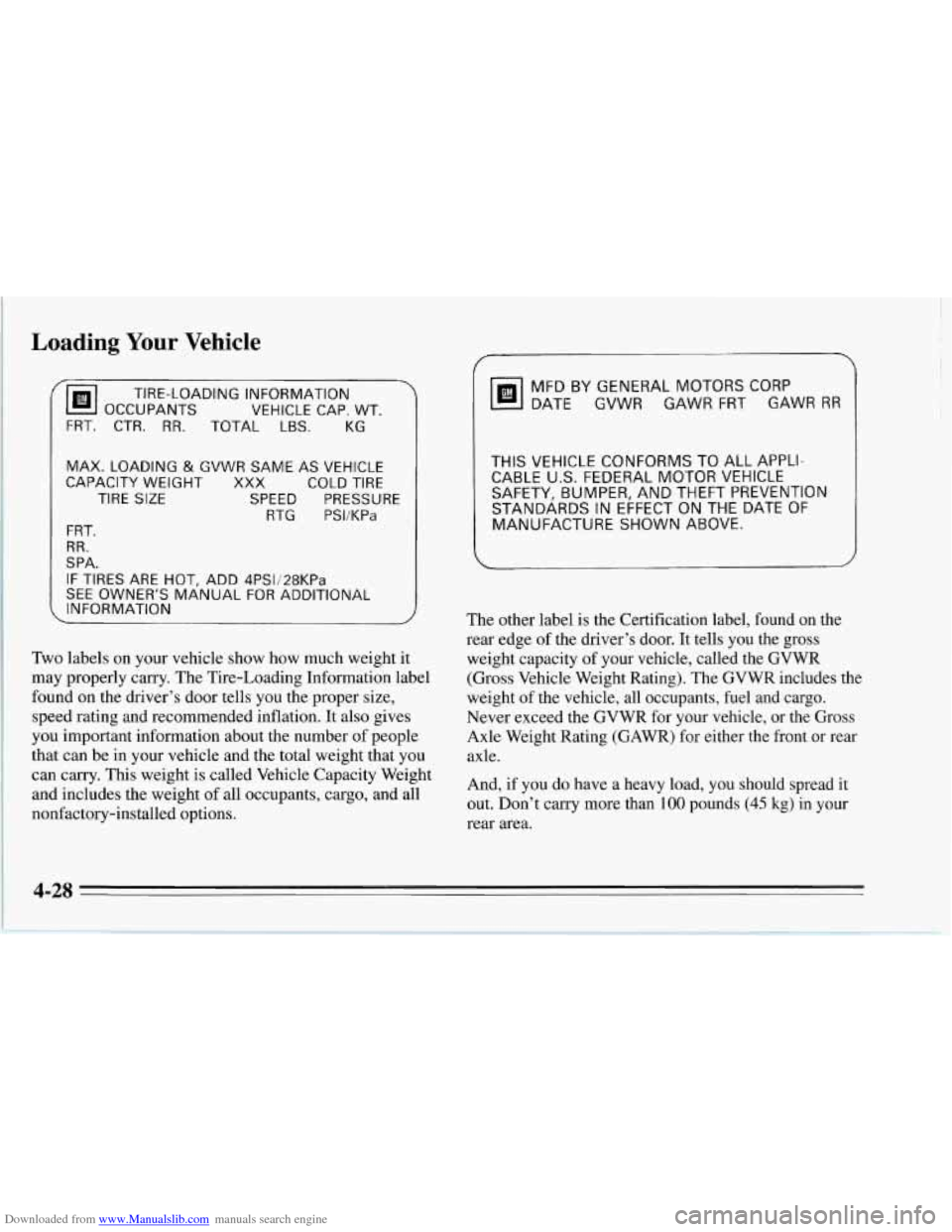
Downloaded from www.Manualslib.com manuals search engine Loading Your Vehicle
OCCUPANTS VEHICLE CAP. WT.
, TIRE-LOADING INFORMATION
FRT. CTR.
RR. TOTAL LBS. KG
MAX. LOADING & GVWR SAME AS VEHICLE
CAPACITY WEIGHT XXX COLD TIRE
TIRE SIZE SPEED PRESSURE RTG PSI/KPa
FRT.
RR.
SPA.
IF TIRES ARE HOT, ADD 4PS1/28KPa
SEE OWNER’S MANUAL FOR ADDITIONAL
INFORMATION
Two labels on your vehicle show how much weight it
may properly carry. The Tire-Loading Information label
found on the driver’s door tells you the proper size,
speed rating and recommended inflation. It also gives
you important information about the number of people
that can be in your vehicle and the total weight that you
can carry.
This weight is called Vehicle Capacity Weight
and includes the weight of all occupants, cargo, and all
nonfactory-installed options.
MFD BY GENERAL MOTORS CORP
DATE
GVWR GAWR FRT GAWR RR
THIS VEHICLE CONFORMS TO ALL APPLI-
CABLE
U.S. FEDERAL MOTOR VEHICLE
SAFETY, BUMPER, AND THEFT PREVENTION
STANDARDS IN EFFECT
ON THE DATE OF
MANUFACTURE
SHOWN ABOVE.
The other label is the Certification label, found on the
rear edge of the driver’s door. It tells you the gross
weight capacity of your vehicle, called the GVWR
(Gross Vehicle Weight Rating). The GVWR includes the
weight of the vehicle, all occupants, fuel and cargo.
Never exceed the GVWR for your vehicle, or the Gross
Axle Weight Rating (GAWR) for either the front
or rear
axle.
And,
if you do have a heavy load, you should spread it
out. Don’t carry more than
100 pounds (45 kg) in your
rear area.
4-28
Page 379 of 386
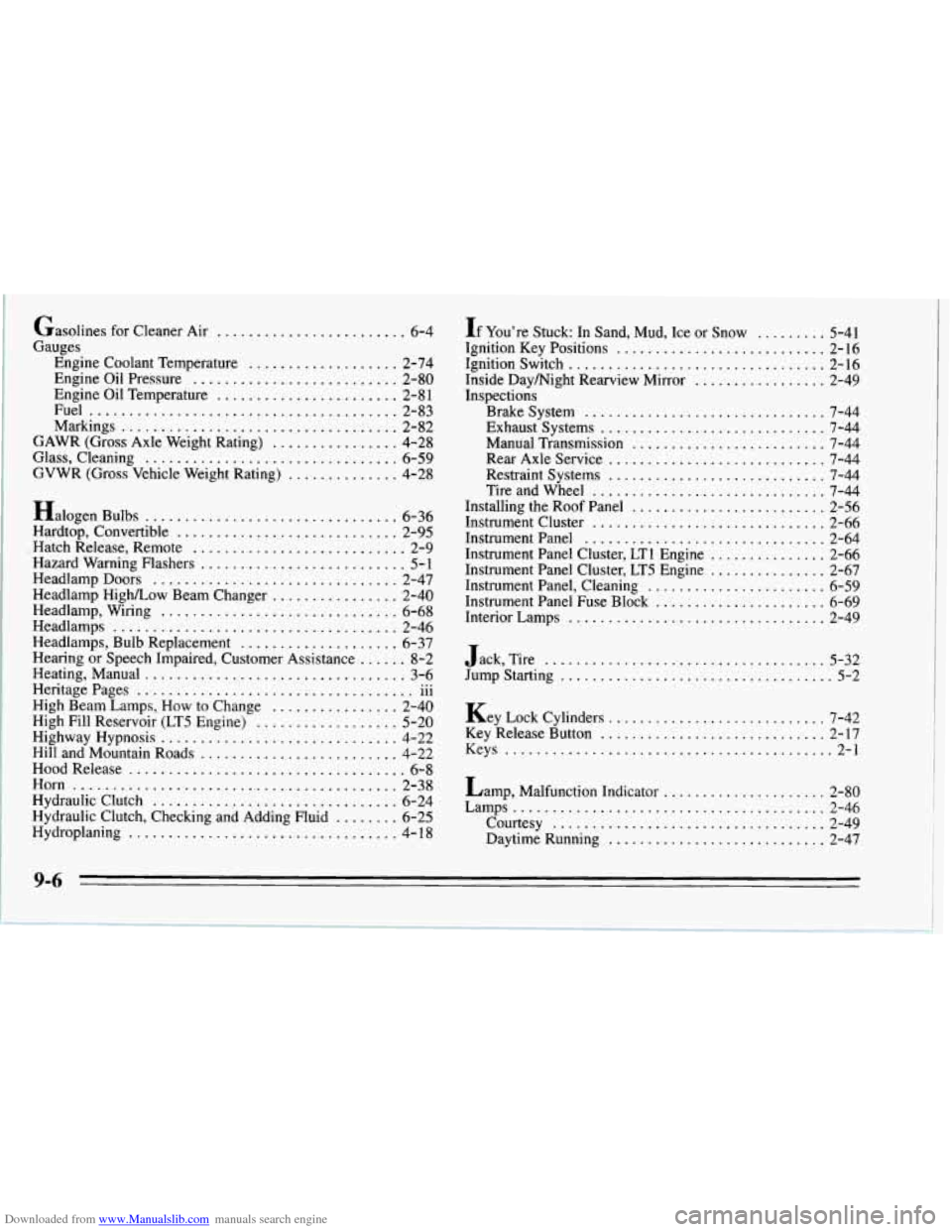
Downloaded from www.Manualslib.com manuals search engine Gasolines for Cleaner Air ........................ 6-4
Gauges Engine Coolant TemDerature
................... 2-74 " Engine Oil Pressure .......................... 2-80
Fuel ....................................... 2-83
Engine
Oil Temperature
....................... 2-81
Markings
................................... 2-82
GAWR (Gross Axle Weight Rating)
................ 4-28
GVWR (Gross Vehicle Weight Rating)
.............. 4-28
Glass,
Cleaning
................................ 6-59
Halogen Bulbs
................................ 6-36
Hardtop. Convertible
............................ 2-95
.Hatch Release. Remote
........................... 2-9
Hazard Warning Flashers
.......................... 5-1
Headlamp Doors ............................... 2-47
Headlamp HigWLow Beam Changer
................ 2-40
Headlamp. Wiring
.............................. 6-68
Headlamps, Bulb Replacement .................... 6-37
Heating, Manual
................................. 3-6
High Beam Lamps, How to Change
................ 2-40
High Fill Reservoir
(LT5 Engine) .................. 5-20
Highway Hypnosis
.............................. 4-22
Hill and Mountain Roads
......................... 4-22
HoodRelease
................................... 6-8
Horn
......................................... 2-38
Headlamps
.................................... 2-46
Hearing or Speech Impaired, Customer Assistance
...... 8-2
Heritage Pages
................................... 111 ...
Hydraulic Clutch ............................... 6-24
Hydraulic Clutch, Checking and Adding Fluid
........ 6-25
Hydroplaning
.................................. 4- 18
If You're Stuck: In Sand. Mud. Ice or Snow ......... 5-41
Ignition Key Positions
........................... 2-16
Ignition Switch
................................. 2-16
Inside Daymight Rearview Mirror
................. 2-49
Exhaust Systems
............................. 7-44
Manual Transmission
......................... 7-44
Rear Axle Service
............................ 7-44
Restraint Systems
............................ 7-44
Installing the Roof Panel
......................... 2-56
Instrument Cluster
.............................. 2-66
Instrument Panel Cluster,
LTl Engine ............... 2-66
Instrument Panel Cluster,
LT5 Engine ............... 2-67
Instrument Panel, Cleaning
....................... 6-59
Instrument Panel Fuse Block
...................... 6-69
Interior Lamps
................................. 2-49
Jump Starting
................................... 5-2
Key Release Button
............................. 2-17
Inspections
Brakesystem
............................... 7-44
Tireandwheel
.............................. 7-44
Instrumentpanel
............................... 2-64
J ack, Tire .................................... 5-32
Key Lock Cylinders
............................ 7-42
Lamp, Malfunction Indicator
..................... 2-80
Keys
.......................................... 2-1
Lamps
........................................ 2-46
Courtesy
................................... 2-49
Daytime Running
............................ 2-47
9-6